Edvard Munch - A Promise Unfulfilled: Main Galleries and The Sackler Wing, Royal
Academy of Arts, Burlington House, Piccadilly, London. 1st
October – 11th December 2005 (AR)
He who fights with monsters might take care
lest
he thereby become a monster.
And if you gaze for long into an abyss,
the abyss gazes also into you.
Beyond
Good and Evil, Friedrich Wilhelm Nietszche
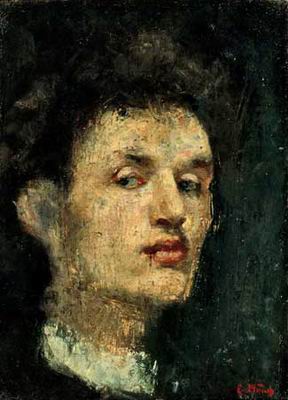
The most revelatory aspect of the Royal Academy of
Arts current exhibition ‘Edvard
Munch by Himself’ is that there is a marked falling off of
powers the older and the more sick Munch became, before dying
at 80. Maybe the exhibition should have been called: ‘The
Rise and Falling Off of Edvard Munch
or ‘Edvard Munch: A Promise Unfulfilled’ as the artist never lived
up to his initial promise and potential.
Beautifully curated by Iris
Müller-Westermann, Curator of International
Art at the Moderna Museet,
Stockholm, the show is divided into six chronological sections
each revealing the relationship between events in Munch’s
‘dis-eased’ life and his angst-ridden art.
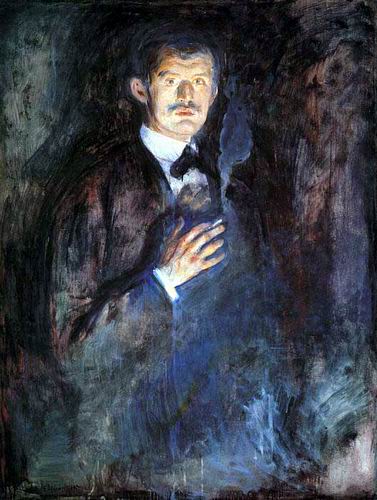
The exhibition opens with three of Munch’s early series of self-portraits from the 1880’s which
showed signs of potential genius: notably Self Portrait with
Cigarette, 1895 where the artist gives us a cold disinterested stare in a haze of drifting
blue smoke complemented by bleeding blue paint dripping off
the image: this image is cool and calculating yet full of
the dread and anxiety to come slowly leaking from the cigarette.
Also striking is his Self Portrait, 1886 which has extraordinarily
subtle scar marks made by the end of the brush cut into the
paint giving us an uncanny sensation of uneasy calm. His debonair
demeanour and stare is smug, condescending and self-congratulatory.
This is his finest self-portrait. A self-portrait that Munch
considered his finest was Self-Portrait with a Bottle of Wine,
1906 which depicts the artist alienated in a bar severed off
from the others around him. Here Munch and a Bottle become
unified in their auto-alienation: each alone but side by side
and waiting for each other to be poured out into each other.
Munch gives the shuddering yet serene sensation of an uneasy
calm and a barely suppressed inner turmoil: he shows us that
we can be absolutely alone amidst others.
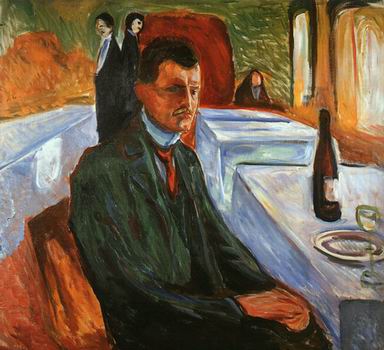
The most disturbingly delightful image on display is Self-Portrait
in Hell, 1903, where Munch’s skin
appears flayed and in flames burnt almost beyond human recognition
with his naked body becoming a flaming torch: yet Munch does
not appear tortured at all but stands stern and indifferent
by being engulfed by flames.
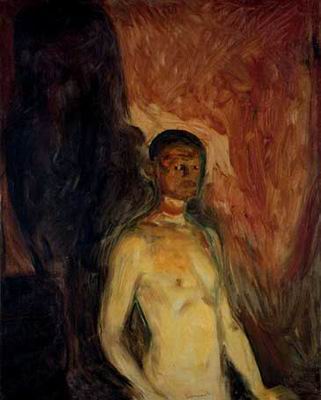
Likewise a striking charcoal drawing Self–Portrait,
1912, has a fluid three dimensional sculptural quality about
it, with powerful meandering, muscular, musical lines; similarly
his musical Self-Portrait with Nude Torso, 1915 has a rugged
but fluent tautness of line missing in later works.
Bricklayer and Mechanic, 1908 is the most interesting
and successful ‘painting’ in the exhibition: by ‘paint’ I
mean non-illustrational ‘painterly’ paint where the paint
makes the image and does not merely fill in the form. Whilst
the face of the figure on the right has no features it still
stares and smiles out at you: the eyes - which are not there - are still horrible to look at.
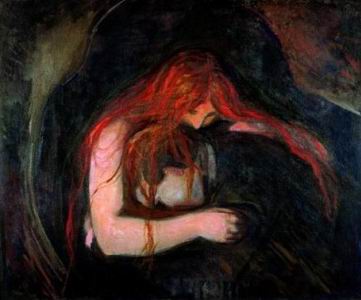
In Vampire, 1893 and The Death of Marat 1, 1907 Munch shows his true misogynistic colours and
paranoid fear of women representing them as unevolved
alien creatures: these paintings unwittingly expose Munch’s
deeply reactionary and conservative attitude towards women
portraying them as threatening and on the verge of devouring
men.
Like Francis Bacon, Munch’s
artistic powers died years before he did and by the early
1920’s his self-portraits became watered down caricatures
and clichés of his former works. This decline is evident in
Self-Portrait: The Night Wanderer, 1923-24, where Munch becomes
a looming ghost of his former self: there is nothing in the
eyes but the promise of death and the paint itself is dry
and dead.
By the 1930’s artistically all
is lost and psychologically Munch lost his head and thus any
sense of self-reflectivity and critical evaluation of his
work. There is no rigorous self-discipline and Munch allows
the paint to get out of control – but not like the elegant
‘ordered chaos’ of Pollock or the brutal ‘thrown chance’ of
Bacon or the anarchic ‘bravura attack’ of Corinth.
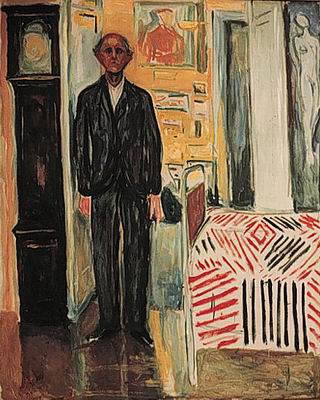
The self-portraits from the
1940’s are pitifully inept and Munch’s handling of the paint
becomes incontinent and etiolated giving the sensation of
diarrhoea whilst his drawing becomes very crude and clumsy
with sloppy brush work reminding one of John Bratby
– or a poor man’s Van Gogh
- as seen in Self-portrait with Hat and Coat 1930.
The decorative influence of Matisse can be seen in Self-Portrait
between Bed and Clock 1940-42: here Munch appears as a skeletal
zombie almost as thin as the Grand Father Clock that he stands
erect by.
Despite painting 70 self-portraits in oils over a
60-year period Munch never really developed as a self-portraitist
in the same way that Rembrandt or Van Gogh did and of these
70 oils only 5 remain of the first rank.
In his self portraits Munch never got away from illustration
(natural realism) and could not reinvent the face or the head
(they are not the same thing) in the radical way that Picasso
or Jawlensky could. There is nothing psychically or dramatically
interesting or inventive in his late self-portraits as there
always was in Rembrandt’s self-portraits. The principal difference
between Munch and Rembrandt is that the latter’s powers and
brilliance in his sheer application and manipulation of oil
paint if anything increased with old age. Munch’s poorly painted late self-portraits are embarrassingly
bad and all signs and sensations of being in the world have
long departed. The final self-portraits of Van Gogh unflinchingly
depict a disintegrating mind and are intensely moving where
the paint is poignant and alive whereas Munch’s
self-indulgences leave us strangely unmoved: we feel no engagement
and little pity.
Munch defined ‘art’ as a symptom of our 'fear of life'
and his later and weak self-portraits may be defined as his
‘fear of painting’ – of ‘losing it’ – and as he lost his head
psychologically he also lost his head aesthetically:
the paint lacked body, his head lacked a face. Whilst
his late self-portraits seek to record the artist’s self-obsessions
with his physical and mental traumas they all remain on the
same level of sensation: a mood of non-presence – of somehow
not being there at all: traces of torn traumas but devoid
of pleasure or pain: just a domesticated dullness: boredom.
Munch is seemingly ‘bored by himself’ and his self-portraits
are about being bored: boredom is his essence and not anxiety
as is often imagined. Munch was the ‘arch depictor’
of Nordic gloom, wallowing in a narcissistic misery signifying
nothing.
Munch spent the last twenty years of his life from
1922 to 1944 in exile at his house in Ekely
where he became obsessed with mortality and filled with dread
and anxiety over his artistic legacy, he instinctively knew
he could no longer paint. On his death in 1944 Munch bequeathed
all of the art works in his possession to the City of Oslo,
which founded the Munch-Museet in
1963. Maybe this was a calculated and cynical move, by a dreary
Nordic bore, to defeat death by immortalising his art in a
morgue?
Alex Russell








